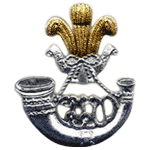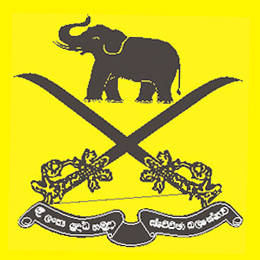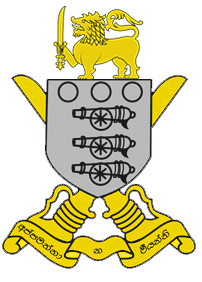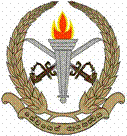
The National Cadet Corps (NCC) is the youth wing of the Indian Armed Forces with its headquarters in New Delhi, India. It is open to school and college students on voluntary basis as a Tri-Services Organisation, comprising the Army, the Navy and the Air Force. Cadets are given basic military training in small arms and drill. Officers and cadets have no liability for active military service once they complete their course.

The Sri Lanka Army is the oldest and largest of the Sri Lanka Armed Forces. Established as the Ceylon Army in 1949, it was renamed when Sri Lanka became a republic in 1972. In 2010, the Army had approximately 200,000 regular personnel, between 20,000 and 40,000 reserve (volunteer) personnel and 18,000 National Guardsmen and comprises 13 divisions, one air-mobile brigade, one commando brigade, one special forces brigade, one independent armored brigade, three mechanized infantry brigades and over 40 infantry brigades.

The Sri Lanka Armoured Corps (SLAC) provides the armour capability of the Sri Lanka Army, with vehicles such as the T-55AM2, and type 80/88 main battle tanks; the BMP infantry fighting vehicle; and the BTR-80, and WZ551 armoured personnel carriers. It comprises five regular armoured regiments, a volunteer regiment, and a regimental band. It has an independent Armoured Brigade and is headquartered at Rock House Army Camp, Colombo.

The Sri Lanka Artillery (SLA) is the artillery arm of the Sri Lanka Army. It is made up of ten regular regiments and two volunteer regiments. The SLA is headquartered at Panagoda Cantonment, Panagoda.

The Sri Lanka Signals Corps (SLSC) is a combat support corps of the Sri Lanka Army, responsible for providing military communications, information technology and electronic warfare support. The corps is made up of a signals brigade, ten regular regiments and one volunteer regiment. It is responsible for installing, maintaining and operating all types of telecommunications equipment and information systems. It is headquartered at the Panagoda Cantonment.

The Sri Lanka Light Infantry (SLLI) is the oldest regiment in the Sri Lanka Army and the oldest infantry regiment in the army. It is made up of sixteen regular battalions and nine volunteer battalions, and is headquartered at the Panagoda Cantonment, Panagoda.

The Sri Lanka Sinha Regiment (SLSR) is an infantry regiment of the Sri Lanka Army; it is the second oldest infantry regiment in the army.

The Sri Lanka Army Volunteer Force (SLAVF) is the active-duty volunteer reserve force of the Sri Lanka Army. The SLAVF is separate from the Regular Force which consists of personal who are professional soldiers and its Regular Reserve, which comprises personal who have a mobilization obligation following their service in the regular army. The SLAVF consists of the volunteer force and the volunteer reserve; administration and recruitment of reserve personal is carried out by the Volunteer Force Headquarters in Shalawa, Kosgama which is headed by the Commandant of the Volunteer Force. It has a current strength of about 55,000 personnel. The SLAVF was known as the Ceylon Volunteer Force from 1949 to 1972 and the Sri Lanka Volunteer Force from 1972 to 1985.

The Sri Lanka Army Ordnance Corps (SLAOC) is a combat support corps of the Sri Lanka Army. The role of the corps is the procurement, receipt, storage, accounting, maintenance, control, issue and disposal of ordnance stores. It is made up of seven regular ordnance battalions, three Base Depots, one volunteer (reserve) ordnance battalion, and many independent ordnance depots. It is headquartered at the Regimental Centre, Dombagoda.

The Sri Lanka Military Academy, commonly known simply as Diyatalawa, is the oldest military academy in Sri Lanka, and trains commissioned officers for the Sri Lanka Army. It is located in the garrison town of Diyatalawa in the central highlands of Sri Lanka. It has capacity to train more than 300 cadets.
General Shavendra Silva, is a Sri Lanka Army general who is the current Chief of Defence Staff, the head of the Sri Lanka Armed Forces serving from 1 January 2020. He also served as the Commander of the Sri Lanka Army from 19 August 2019 to 31 May 2022. His other important appointments include, Chief of Staff of the army, Adjutant General and Director of Operations of the Army. During the Sri Lankan civil war he gained fame as the General Officer Commanding of the elite 58 Division. He had also served as the Deputy Permanent Representative to the United Nations Headquarters.
General Shantha H.S. Kottegoda, WWV, RWP, RSP, VSV, USP is a retired senior Sri Lanka Army general. He was the seventeenth commander of the Sri Lankan Army from 1 July 2004 – 5 December 2005. He had served as the Sri Lankan Ambassador to Brazil and Thailand. In April 2019, following the Easter Sunday bombings he was appointed as the permanent secretary to the Ministry of Defence.
Major General Sumith Balasuriya, VSV, USP is a retired Sri Lankan army general, who was the former Commandant of the Volunteer Force; Vice Chancellor, General Sir John Kotelawala Defence University and GOC, 23 Division.
Major General Gemunu Kulatunge, RSP, USP, ndc, psc (1941-2003) was a Sri Lankan army general, who was the former Deputy Chief of Staff of the Sri Lanka Army.
Major General C.H. Fernando, VSV was a senior Sri Lanka Army general, who was the former Director of Operations, General Staff; GOC, 2 Division; Commander, Northern Command.
Major General Y. Balaretnarajah, VSV, USP, ndc is a retired Sri Lankan army officer. He had served as Chief of Staff of the Sri Lanka Army, Commandant of the Volunteer Force and Commander - Jaffna Security Forces. He has commanded the 1 Division, Armoured Brigade, 21 Brigade and 24 Brigade.
Major General E. George Thevanayagam, VSV was a Sri Lankan general, he served as the Chief of Staff of the Sri Lanka Army, Commandant of the Volunteer Force, and later first Director of the National Cadet Corps.

General Lionel Piyananda Balagalle,, was a senior Sri Lanka Army officer, who served as the Commander of the Sri Lanka Army and the Chief of the Defence Staff. He is known for formalising military intelligence operations within the Sri Lanka Army, having founded the Directorate of Military Intelligence and the Military Intelligence Corps.
Brigadier John Fredrick Halangode, VSV was a Sri Lankan army officer. He founded of the Gemunu Watch, having served as the first commanding officer of the 1st Battalion, Gemunu Watch.
Major General C. A. Mike N. Silva, VSV was a senior Sri Lanka Army officer who served as the Chief of Staff of the Army and the Commandant of the Volunteer Force. He was the first Commandant of the Kotelawala Defence Academy.


















